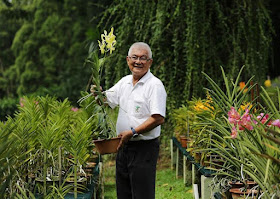Source Website: http://news.asiaone.com/news/science-and-tech/plant-keepers
By Feng Zengkun, The Straits Times, Saturday, 11 July 2015
By Feng Zengkun, The Straits Times, Saturday, 11 July 2015
PHOTO: National Orchid Garden nursery manager David Lim says it is usually the hybrid's mother that determines its flower's size and shape.
Photo: ST
https://blogger.googleusercontent.com/img/b/R29vZ2xl/AVvXsEi5hyphenhyphenL8UYwjs_C1KLcs0QGoIuCN6hy1XOyUe1Usb7V9YKJXXupvQCewrILHc8pYpmf-sP09YZIokvtwWdJqTSsH-Cu3R4a9Myg0Ylub3hXNR7zghEgk2ukV1zfdehv3yJAFCC42V_rv9Jo/s1600/20150710_Hybrid_Nparks.jpg
http://news.asiaone.com/sites/default/files/styles/w848/public/original_images/Jul2015/20150710_Hybrid_Nparks.jpg?itok=rcNinpQ6
http://news.asiaone.com/news/science-and-tech/plant-keepers
Singapore Botanic Gardens was made a Unesco World Heritage Site last week, becoming just one of three gardens in the world, and the only one in Asia, to earn that honour. The Straits Times speaks to the passionate men and women helming plant research there.
Displayed in the Botanic Gardens' herbarium is a sprig of jasmine that has been preserved for more than 200 years.
Collected by missionaries in India in the year 1790, the plant was brought to Singapore and donated to the Gardens around 1879. While the dried specimen might not be much to look at, it is one reason Singapore has been feted as a leading centre of tropical plant research.
After the Gardens was founded in 1859, its herbarium was set up in 1875 to collect, document and preserve plants in the region.
It has amassed a vast collection of about 750,000 dried plant specimens and 15,000 plant samples preserved in alcohol, making it a crucial stop for botanists seeking to understand South-east Asia's flora.
Dr David Middleton, 51, the herbarium's keeper, said of its roots: "When it was founded, it was the main herbarium for Malaya."
He added: "Even after Singapore's independence from Malaysia in 1965, all of the collections remained here in Singapore."
In the past two years, seven new plants have been found in Singapore and named in scientific papers.
These discoveries came after researchers compared their finds in the field to specimens in the herbarium's archives.
Its specimens are as diverse as they are extensive: Aside from the 225-year-old jasmine sprig, one section contains a century's collection of gingers from Penang, Perak and Pahang dating from the 1890s to the 1990s.
There are also specimens from the Cratoxylum glaucum Korth, a small tree first found in Bangka, an island east of Sumatra, Indonesia, in 1802, and from the Nepenthes klossii, a tropical pitcher plant first found in Papua, Indonesia, in 1912.
Some of the herbarium's plants once grew in Singapore but are now extinct here, such as the Thrixspermum psiloglottis (Ridl.) Schltr, an orchid with pale yellow flowers first found in Malaysia.
Every two weeks, a small team from the herbarium ventures into Singapore's green spaces, such as the Central Catchment Nature Reserve, to collect new specimens and learn more about the plants.
The researchers also survey sites in other parts of the South-east Asian region such as Brunei, Vietnam, Laos and Malaysia.
Dr Middleton, who is also the Gardens' deputy director and is in charge of research and conservation, said
the field trips allow experienced staff to mentor their junior colleagues, so that skills are passed from one
generation of botanists to the next. "There are more than 2,000 native species in Singapore, and the easiest way to identify them is when they are in flower or fruit, but that doesn't happen most of the time," he said.
"It's a great skill to be able to identify a plant, and the longer you do it, the better you get."
The regular surveys also enable the researchers to monitor changes in the landscape, sound the alarm about disappearing plants and inform conservation decisions - work that has become easier due to modern technology.
Ms Bazilah Ibrahim, 27, who helps manage the herbarium's collection, explained: "Some of the early collectors wrote very vague labels for their specimens, partly because they didn't have the equipment that we have now.
"The label might say Changi Road, for example, but we wouldn't know exactly where in Changi Road the specimen was collected.
"Now, we have GPS (global positioning system) and can pinpoint the co-ordinates."
Other labels have become obsolete, she added. "We've come across labels that say Chan Chu Kang. You can't find that on a map now, and you might assume that it was misspelt and actually means Choa Chu Kang. But there used to be a Chan Chu Kang. It just doesn't exist any more."
By Feng Zengkun, The Straits Times, Saturday, 11 July 2015
Reference
- https://blogger.googleusercontent.com/img/b/R29vZ2xl/AVvXsEi5hyphenhyphenL8UYwjs_C1KLcs0QGoIuCN6hy1XOyUe1Usb7V9YKJXXupvQCewrILHc8pYpmf-sP09YZIokvtwWdJqTSsH-Cu3R4a9Myg0Ylub3hXNR7zghEgk2ukV1zfdehv3yJAFCC42V_rv9Jo/s1600/20150710_Hybrid_Nparks.jpg
- http://news.asiaone.com/sites/default/files/styles/w848/public/original_images/Jul2015/20150710_Hybrid_Nparks.jpg?itok=rcNinpQ6
- http://news.asiaone.com/news/science-and-tech/plant-keepers
